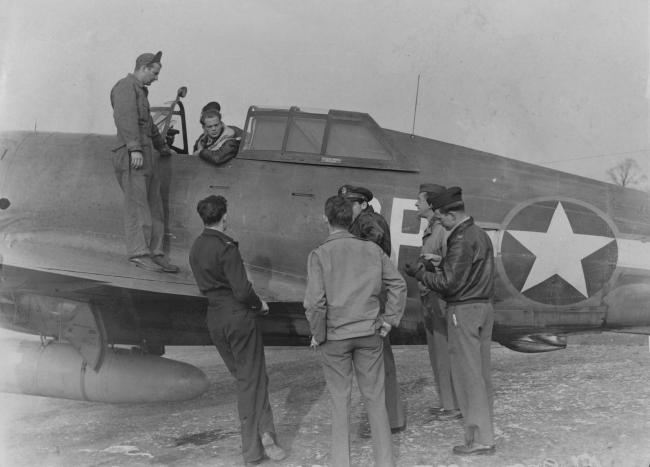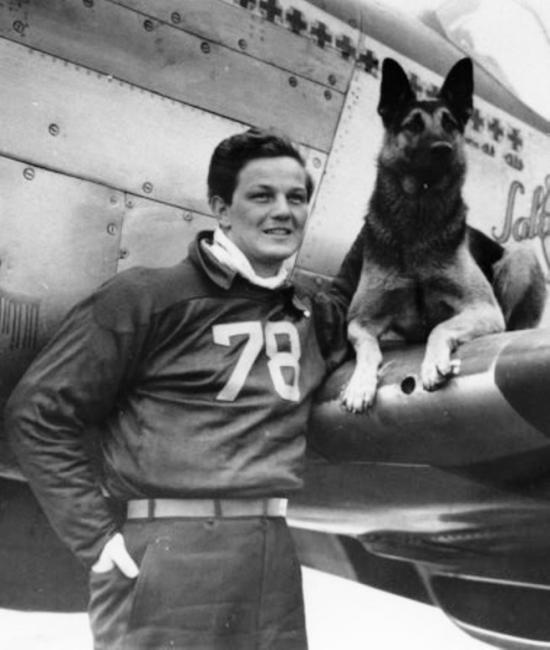Ralph Kidd Hofer
Military ROLL OF HONOUR
IWM, Roger Freeman Collection
Object Number - FRE 30 - Ace pilot with the 4th Fighter Group, First Lieutenant Ralph K. Hofer, from Salem, Missouri, seated in cockpit with ground crew standing on the wing,...
Ralph Kidd Hofer was born Ralph Kidd Halbrook on a farm near Salem, Missouri, in 1921. Upon his father's death, when Ralph was only four, his mother remarried and his name was changed to Ralph Kidd Hofer. Eventually the name "Kidd" stuck with him throughout his combat career.
He loved the outdoors, animals, and sports. He drifted naturally into semi-pro football and boxing. In 1940 he won a trophy in a Golden Gloves tournament as a light heavyweight. In 1941 He heard of good purses being pail in American Legion bouts in California. He arranged with a promoter to pick up new car in Detroit and deliver it to him in California in return for his travel expenses.
As the story goes, while waiting for the car to be finished he crossed over to Windsor, Ontario, Canada, on a lark. A border patrolman, assuming he was attempting to join the Royal Canadian Air Force (RCAF), directed him to the recruiting station. Hofer had no interest in in airplanes or flying, but he was caught up in the exuberance of the applicants he found there, and he immediately enlisted. He was soon became addicted to flying. When he graduated from flying training he visited Chicago, where he was solicited to appear in a billboard promotion for Coca-Cola. He was handsome, powerfully built, with a perpetual smile, and looked great in his RCAF uniform. Posing with a U.S. cadet, he personified the advertisement, which claimed "Thirst Knows No Boundaries".
After 223 hours he completed his flight training and shipped to an Operational Training Unit in England in October 1942 for advanced training. In January 1943 he had his first flight in a Hurricane. Thirteen days later, he barely missed "pranging" his aircraft in a dead-stick landing because he he neglected to switch his fuel tanks, causing his engine to quit. He was assigned to an operational unit, which proved boring. In order to overcome the boredom he became reckless. Buzzing low, he chopped six inches off his prop, and two days later he tore off his tail wheel!
As a Sergeant Pilot he managed to obtain a transfer to the USAAF, thereby becoming a Flight Officer training in P-47s. In July 1943 he was assigned to the 4th Fighter Group, 334th Squadron at Debden.
With the advent of the day-bombing tactics of the USAAF, the mission of the longer range U.S. fighters became one of protecting their bombers from the German fighters as they defended their homeland. The fighter mission, became "protect the bombers, and protect each other". A wingman was expected to stay with and protect his unit leader so he could attack the enemy and not fear an enemy attack from his rear. The unit leader, meantime, was to protect his wingman in the same manner.
Hofer was a good pilot, but tended to disregard these basic tactics in order build up his personal score. Fortunately, he was also extremely lucky in escaping many dangerous situations, since he was insecure in his ability to fly instruments and his navigational skills left a lot to be desired. His disregard of aerial discipline earned him many reprimands, but it was not confined entirely to the air. He was picked up in London by MPs for not wearing his rank insignia, at which time they discovered that he was not even carrying his identification card.
The Kidd's first combat mission was what was to become a routine for him. He became separated from his element leader when they were attacked by Luftwaffe planes and he headed home alone. On the way he encountered an enemy aircraft attacking a P-47. He was able, undetected, to come up behind the German and blast him, but too late to save the other P-47. With minor changes in detail this sort of episode happened frequently, and soon Hofer was the first Flight Officer to become an "Ace", followed shortly by earning the Distinguished Flying Cross. On 22 April he was promoted to Second Lieutenant.
In due course 6 June found the 4th involved in protecting the beach-head during D-Day. The Kidd's luck held, as his flight of four P-51s was bounced by a superior group of Me-109s, and three of the Mustangs were shot down, with only Kidd surviving. Within a few days he was grounded for refusing to have immunisation shots required for a secret mission. Finally, he relented, and had his shots, and became eligible to go on the mission, a bomber escort "Shuttle Flight to Russia, on to Italy, and back home to Debden.
Because of the length of the first leg of this mission, orders were issued that there were to no attacks on enemy aircraft except to protect the bombers, and formation was to remain intact throughout. A brief combat ensued over the bombing target and, as usual, Hofer disappeared. When the Group arrived in Russia two fighters were missing; one that had been shot down and Hofer's. Hofer had gotten lost and, with only a few drops of fuel left, had managed to land at an airfield near Kiev. He was to remain there for four days, as the suspicious Russians kept him in protective custody while they checked his identity before sending him to rendezvous with the rest of his group.
He later flew back to his original destination only to find that the Group had already left on the second leg of the mission to Italy. Three planes remained behind with engine problems. When they became airworthy the four left for Italy. Two hours into their flight one pilot suggested to Hofer that he was flying on the wrong heading. However, Hofer remained adamant, so the two others left to pursue a different course. One arrived in Italy at the destined base and one landed in Sicily. Hofer, running out of fuel followed a flight of British planes and landed in Malta - hundreds of miles off course.Five days later he rejoined his group.
On 2 July 1944 the 4th joined fighters from the 15th Air Force to escort bombers on a raid to Budapest, Hungary. A group of Me-109s came up in force, and Ralph's element leader, having engine trouble, was shot down; Hofer then went off alone and was never seen again.
Assuming that Ralph had been shot down, there ensued many stories as to who was responsible, for the kill. Hofer was such a high-scoring icon that any German pilot would have been proud tom have credit for his destruction. Research soon discovered that two of the major claimants' stories were dismissed as false. It then became possible that he had been shot down by a young Hungarian pilot,, but unfortunately, before the investigation could be completed, this pilot was killed. In any event, Hofer's plane had crashed with his body in it, and he was buried in Mostar, Yugoslavia, about three hundred miles from where his group had engaged in fighting the Luftwaffe. Years later, investigation concluded that the most likely cause of the Kidd's demise was a flak battery, and that in his final act he rammed the battery as he went down, killing some of the gunners.
Despite his behavior and rogue tactics he flew 74 missions with the 4th Fighter Group and scored 30.5 enemy aircraft destroyed. He was awarded the Distinguished Flying Cross with three Oak Leaf Clusters, the Air Medal with one Oak Leaf Cluster, and the Purple Heart.
Hofer's body was later reintered at a mass grave at Jefferson National Cemetery.
Connections
See how this entry relates to other items in the archive by exploring the connections below.
Units served with

- Unit Hierarchy: Squadron
- Air Force: Eighth Air Force
- Type Category: Fighter

- Unit Hierarchy: Squadron
- Air Force: Eighth Air Force
- Type Category: Fighter
People

- Military/Civilian/Mascot: Mascot
- Nationality: British
- Unit: 334th Fighter Squadron
- Role/Job: Mascot
Aircraft

- Aircraft Type: P-47 Thunderbolt
- Nicknames: The MISSOURI KIDD & SHO-ME

- Aircraft Type: P-51 Mustang
- Nicknames: Salem Representative
- Unit: 4th Fighter Group 334th Fighter Squadron
- Aircraft Type: P-51 Mustang
- Nicknames: Salem Representative
- Unit: 4th Fighter Group 334th Fighter Squadron
- Aircraft Type: P-51 Mustang
- Unit: 4th Fighter Group 334th Fighter Squadron
Places

- Site type: Airfield
Events
| Event | Location | Date | Description |
|---|---|---|---|
|
Born |
Salem, Missouri | 22 June 1921 | |
|
Died |
Mostar, Yugoslavia | 2 July 1944 | Killed in Action |
|
Buried Killed in Action (KIA) |
Jefferson Barracks National Cemetery | ||
| Chicago, IL, USA | |||
|
Other Detached Service 335th Figther Squadron |
Revisions
Personal research & 'Eighty-One Aces of the 4th Fighter Group' by Frank Speer.
Merged data from duplicate record to include data from :
- Ted Damick, VIII Fighter Command pilots list.
Service Number in Ted Damick record was : T-190836
Freeman, The Mighty Eighth, pp. 278-279.
http://www.findagrave.com/cgi-bin/fg.cgi?page=gr&GSln=hofer&GSfn=Ralph&…;
http://www.combatsim.com/memb123/htm/2002/12/kidhofer/
http://acepilots.com/usaaf_eto_aces2.html#Hofer
Drawn from the records of the National Museum of the Mighty Eighth Air Force, Savannah, Georgia / Fighter Aces of the U. S. A. and Mustang Aces of the Eighth Air Force; MACR 6801 / MACR 6801 / Paul Andrews, Project Bits and Pieces, 8th Air Force Roll of Honor database / Ted Damick, VIII Fighter Command pilots list










